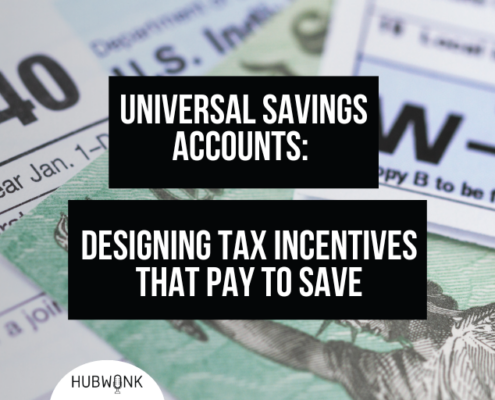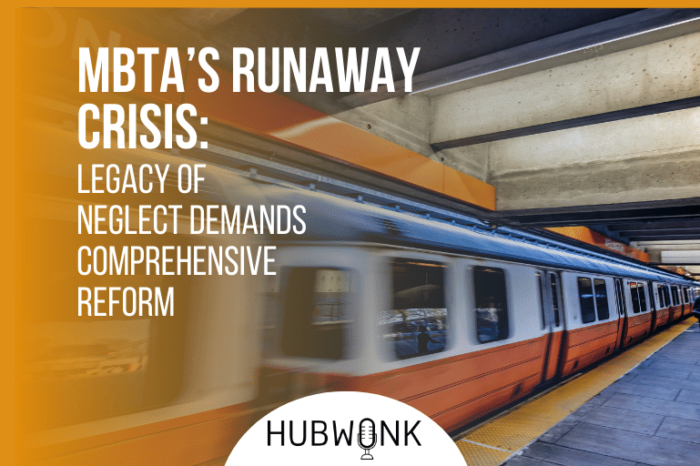MBTA’s Runaway Crisis: Legacy of Neglect Demands Comprehensive Reform
/in Blog: Transportation, Featured, News: Transportation, Podcast Hubwonk /by Editorial StaffThis week on Hubwonk, host Joe Selvaggi talks with Andrew Bagley, Vice President for Policy and Research at Massachusetts Taxpayers Foundation, about their recent report entitled, The MBTA Crisis is Complicated – Fixing It Will Be Too, diving into the details on why the T is in crisis and what the public must demand of policy makers to get it back on track.
Guest:
 Andrew Bagley is Vice President for Policy and Research at the Massachusetts Taxpayers Foundation (MTF), which he joined in 2007. He prepares tax revenue forecasts for the state, analyzes state revenues, capital budgets and spending plans, transportation finances, the impact of demographics on the state’s economy, the state’s unfunded liabilities and the Stabilization Fund. In 1989 Mr. Bagley co-founded International Strategies Inc., an Internet software company developing tools for global trade for Fortune 500 clients and sold the company in 2006. Previously he was Deputy Secretary and Executive Director of the Massachusetts Office of International Trade in the second Dukakis administration and staff member to U.S. Senator Paul Tsongas. Prior to that, he worked as an environmental economist at GCA Technology and a bio-medical researcher at Thermo Electron working on artificial heart pumps. Mr. Bagley has a B.A. in government and philosophy from Colby College, an M.A. in economics from the University of Oregon, and a Masters in city and regional planning from Harvard University where he was a department scholar.
Andrew Bagley is Vice President for Policy and Research at the Massachusetts Taxpayers Foundation (MTF), which he joined in 2007. He prepares tax revenue forecasts for the state, analyzes state revenues, capital budgets and spending plans, transportation finances, the impact of demographics on the state’s economy, the state’s unfunded liabilities and the Stabilization Fund. In 1989 Mr. Bagley co-founded International Strategies Inc., an Internet software company developing tools for global trade for Fortune 500 clients and sold the company in 2006. Previously he was Deputy Secretary and Executive Director of the Massachusetts Office of International Trade in the second Dukakis administration and staff member to U.S. Senator Paul Tsongas. Prior to that, he worked as an environmental economist at GCA Technology and a bio-medical researcher at Thermo Electron working on artificial heart pumps. Mr. Bagley has a B.A. in government and philosophy from Colby College, an M.A. in economics from the University of Oregon, and a Masters in city and regional planning from Harvard University where he was a department scholar.
Get new episodes of Hubwonk in your inbox!
WATCH:
Read a Transcript of This Episode
Please excuse typos.
Joe Selvaggi:
This is Hubwonk, I’m Joe Selvaggi.
Joe Selvaggi:
Welcome to Hubwonk, a podcast of Pioneer Institute, a think tank in Boston. The MBTA is in full-blown crisis. So says a recent report released by the Massachusetts taxpayers foundation. Greater Boston’s public transit system has been plagued by seemingly intractable safety and service problems that include deadly accidents and the current one month shutdown of the entire orange line from Oak Grove in Malden, Forest Hills and Jamaica Plain. The beleaguered T has seemed immune to reform despite the attention of regional elected officials, including the skills of outgoing Governor Baker, who made fixing the T a cornerstone of his 2015 policy agenda after witnessing the complete failure of the red line a month into his first term. Now in the final months of his second term, the governor must look on as the federal transit administration steps in from Washington and imposes safety, shutdowns, and comprehensive improvement mandates.
Joe Selvaggi:
Now with the certainty of new leadership in the State House, an impatient public must demand fundamental reform to ensure our prosperous region is not hamstrung by a dysfunctional public transit system. How did we get here? What is the nature and scope of the problems and what should the public demand from policy makers to put the T on track for future service excellence? My guest today is Andrew Bagley, vice president for policy and research at Massachusetts Taxpayers Foundation, who led the research team that released the report entitled “The MBTA crisis is complicated: fixing it will be too.” The report analyzes the sources and magnitude of the T’s challenges, including the past fiscal and management missteps, and recommends needed changes. The next governor, state legislators, and congressional delegates must make to resuscitate the T to better serve the future vibrant, greater Boston economy. When I return, I’ll be joined by Massachusetts Taxpayers Foundation’s Andrew Bagley. Okay. We’re back. This is Hubwonk. I’m Joe Selvaggi, and I’m now pleased to be joined by vice president for policy and research at the Massachusetts Taxpayers Foundation, Andy Bagley. Welcome to Hubwonk, Andy.
Andrew Bagley:
Thank you, Joe. Pleasure to be here.
Joe Selvaggi:
Okay, well, we’re going to dive into an area of research that you studied deeply. But our listeners, I think are all perhaps equally perplexed by it. We’re gonna talk about the T, or the MBTA. It’s top of the news this week, this month, and it has been, I think really for the last seven years,ith its various problems. So,assachusetts Taxpayers Foundation just released a report entitled “The MBTA crisis is complicated: fixing it will be too.” So it’s my hope in the time we have together to have our listeners, hopefully, find it a little less complicated when we’re talking about solutions. So let’s start slowly at the beginning and give our listeners a little bit of context about the size of the MBTA, how many people are on there. And we’ll go from there. So,here, how big is the T in terms of moving people, us, us Bostonians and regional people around?
Andrew Bagley:
Well, pre-pandemic, there were probably about a million trips per day during the weekday. I think we’re down to about 60% of that, and that fluctuates Monday through Friday ridership, although it’s starting to climb back a bit.
Joe Selvaggi:
Okay. That was soof course, the pandemic was disruptive to everyone. One hopes that we will gradually return to pre-pandemic levels, but let’s set that aside for a second, what the trains need to run, whether they’re full or not. What is the budget for that? Let’s assume it’s between 600,000 – a million people? How much does the budgetthe T spend each year to get that done?
Andrew Bagley:
So we’ll look at the latest fiscal year. The full budget is about $2.4 billion, about $500 million of that is debt servicepaying for old debt principal interest. So the operations side is about 1.9, just under $2 billion.
Joe Selvaggi:
So 2 billion, you, you mentioned debt servicing that’s I guess not a productivethat goes to the bank. The remaining $2 billion. How does that break down? We’re often heard, told there’s line items such as of course maintenance is, you know, getting through the daythere’s repairing tracks and old cars. And of course then there’s the ambitious plans to improve or grow the service like the green line extension and such. So how does that money break down by those categories?
Andrew Bagley:
So the first thing you need to do is separate the operating budget from the capital budget mm-hmm <affirmative>. So the operating budget really is about the operations and maintenance of the bus commuter rail, the ferries, and rapid transit the four major modes, if you will. And you can break that down further by what costs go to personnel, what costs go to materials your personnel costs are probably around 700 million, probably another three, 400 million for material supplies, separate breakout for electricity, because I think the T is one of the largest is not the largest consumers of electricity. Commuter rail is a contract out to Keolis, it’s probably around 450 500 million. We also run the pair of transit service, which costs about 120 million. So so it’s complicated. The top line numbers all fall into the bus operators for the rapid transit, et cetera, whereas you can break out specific costs for commuter rail paratransit, the fairies that are done through contractors.
Joe Selvaggi:
Okay. I don’t wanna get too bogged down in the weeds of those details, but I just, I’m curious again, this is a big system buses, trains, light rail many modes who decides when we’re, you know, that next dollar is coming in. Where does that money go? Should it go to a little more maintenance or a little more expansion of service or a little newer car, what, who decides where the money or the resource for the T gets spent?
Andrew Bagley:
Well, certainly the general manager obviously is, is driving that along with the the assistant GMs responsible for operations responsible for capital. During the six years that the fiscal and management control board was in oversight which was sort of a soft receivership, they reviewed those very rigorously and had robust conversations about exactly what the priority should be. Much of that was driven by how thet could find efficiencies to produce same level of services, maybe for less money. They had the exemption from the Paco law, for example, which allowed them to look at alternative ways, contracting out for services. So a lot of this is driven by how can we provide the level of service while seeking ways to do it less to maintain a balanced budget.
Joe Selvaggi:
So the general manager again, you mentioned the FMC B the fiscal management control board that’s as you say, soft soft receivership, in other words is an oversight of a, of a system that perhaps managed itself in the past. So together they decide, which is the right path for improving the T some of that is efficiency. I, I know you mentioned I know personally that they privatized what was it, the money counting system? This is a while back, right? To the consternation of, of some of the people who had been doing that before. But those kinds of efficiencies so to do, to do more with less presumably. So let’s talk about where the money for the tea comes from. And I think perhaps this is worthy of our attention because it’s up for much debate. We, you mentioned a $2 billion expense. We know from studying cities around the world, no no rapid transit system pays for itself ever. So how does our T pay for itself?
Andrew Bagley:
Well, before the pandemic fair revenue contributed about a third, about a little over 33% of the bottom line, 2.4 billion that’s now dropped to about 19% and just a significant loss of ridership, particularly in commuter rail where a significant amount of fair revenue came in in relationship to the number of riders. The state provides funding through a pre budget transfer predicated on sales tax revenues. That’s about 55% about 1.3 billion in this current fiscal year, the legislature appropriated about 187 million to the T this year. That’s about 8%. You also have municipal governments contribute about 8%. And then there’s the, the Lev remaining federal relief funds. They received a total of about 2 billion and they spread that over FY 20 21, 22. Some of those monies are currently used in 23, and they may have a little bit left for 24. So the federal funds they’re one time they will disappear very shortly in which case the te will have to figure out how do they backfill those fed funds.
Joe Selvaggi:
So let’s take those one at a time. You, you, you clearly have a wonderful familiarity with the, with the numbers fairs are no longer as high a percentage of, of the cost as they were. Forgive my naive question, but when ridership goes down, does service go down, in other words, is, is there a, are, are costs constant, or do they in some ways get reduced when ridership falls off or, or, or is it a straight line?
Andrew Bagley:
Well, that’s an interesting question. The, when the MBTA was looking at the impacts of COVID in, in 2020, they were looking that they had received an initial, I think about a billion dollars in federal funds. They knew they had, but they were looking at multiple years of shortages. So they were trying to reduce services to cons to basically reduce costs and what lawmakers and, and including the congressional delegation made clear was, look, we’re, we’re getting you these federal funds, you need to run full service. So the MBTA kept running relatively close to full service, or as close as they could, that was disrupted more by issues of drivers operators having COVID or now they have shortages of personnel, both in the operators of rail lines and bus drivers. These are, they’re becoming increasingly hard to hire. There’s a lengthy process to hire operators and bus drivers. So they’re running effectively full service tied to their human capacity at this point.
Joe Selvaggi:
I see. So there’s really not a relationship or has not been a relationship between ridership and costs. Ridership goes up and down costs remain relatively constant. You talk about tax revenue. We’ve heard about despite the, the COVID pandemic that sales have been robust in the state ha has, has that not in any way compensated for the reduction in, in ridership revenue.
Andrew Bagley:
So the sales tax revenues that come a percentage of which goes to the MBTA those numbers are up about 200 annually from the beginning of COVID. So that is a fairly robust amount of money increase for the T and it is that’s a floor, so that money never goes down. It will remain constant for years, if you don’t see growth in sales tax revenue. So year over year, but that was a a, a good source of new revenues. The problem though, is their expenses are now back growing over 4% per year, and their revenues are sub 2%, particularly when you realize that fair revenues are down as much as they are. And that trend line means that they’re likely to run a two to 300 billion, a million, sorry, two to 300 million operating problem in fiscal 24. And that will continue to grow out to 400, maybe even 500 million. So this was a, a problem they had back in the pre 2015 before the control board, where expenses were growing far faster than revenues. The T was made some real progress in controlling cost growth, but they’re having to hire a lot more people for safety. They’re now responsible for the operations of the green line extension in south coast rail, which will lose about 40, 50 million a year. When you think about the cost versus net new revenues and those operating costs just continue to grow.
Joe Selvaggi:
So the divergence between the, the revenue and the costs have started way back 2015, but I think your organization is, is characterized. What’s coming up as a fiscal cliff. That is, I think that divergence between costs and revenue exists. It had existed before it was structural, but it was somewhat papered over by the money given by the federal government that’s going to ultimately run out. You can see it and perhaps those who study it more closely also can see it. We’ve had, as you say, a soft receivership that has tried to reign in costs and has had some success, but clearly not enough. So let’s get into the hard part of, of, of the conversation, which is if, if we’ve tried software receivership and it doesn’t seem to be working with your organization or you personally, you know, what can be done, let, let’s start at the, at the top level, in a management perspective, you know, is this a sort of a failure of effective management or are these very effective managers that are just not given enough money?
Andrew Bagley:
So before we jump into just this conversation, which is really targeted on the operating budget, we should have also a conversation about the capital budget.
Joe Selvaggi:
Sure.
Andrew Bagley:
So the capital budget is how do you actually fix your infrastructure? Mm-Hmm <affirmative> and you, the, the BTA, like many other agencies sell bonds or 20, 30 years, and that’s how they acquire the debt to pay for new red line cars, new orange line cars, fixing signals, tracks, power the backlog of assets that are in need of repair is well in excess of 10 billion could be higher.
Joe Selvaggi:
So, so I just wanna make sure I understand. So you’re saying take a snapshot today. If we wanted to bring everything up to, you know, working fitness, we would need to invest 10 billion, you know, forgive the, the crudeness of the term, but just to get back to zero were 10 billion in the hole at this moment,
Andrew Bagley:
If you just wanted to replace all of the existing infrastructure that is is below par mm-hmm <affirmative>. But if you also wanna modernize which means that you don’t repair, you don’t replace a rail with an equivalent rail, you, you replace it with something as better technology better performance. So you’re really upgrading as well. So the MBTA put out a a report actually a presentation at the end of the control board last year in June and said not thinking about how much money we have just thinking about how much money do we need to spend over the next 10 years on the existing system, including green line extension in south coast rail, cuz those were underway. And they arrived at a figure around 25 billion. During that 10 year period resources they could point to were about 13 billion and that includes the new federal infrastructure money.
Andrew Bagley:
So as of last June, they were about 12 billion short over the next 10 years. Just to deal with the existing system that does not include climate resilient infrastructure, which Lord knows that’s another couple of billion. The, the tea is working on an updated capital assessment need study that will come out this fall. That will be much more indicative because I think they’ll have much more information on what it’s gonna take to protect their assets from climate change, sea level rise, storm surge. So we’ll have a, a better handle or more accurate handle, but I suspect the number is going to be larger than 25 billion and the gap will be larger than 12 billion. So that’s how do you actually improve the system? I mean, if you wanna replace the red line cars, the orange line cars, you have to not only buy them, but you have to get them prepared, tested in online and running. And all of that comes out of the capital budget. So when we talk about a cliff, we’re actually talking about two, one is the operating budget, which they legally have to balance every year. And the second is a capital budget that says these are the investments we need to make to make sure we have the, the safe, reliable service that everybody is expecting and demanding.
Joe Selvaggi:
So to me, the again, for those scholars who are studying this topic and those managers who are on the front lines trying to make it happen it’s not a mystery of how, what the shortfall is, what seems to be the mystery is where the money’s going to come from. So if you know, you you’ve brought that into our focus is it a rhetorical question where this money gonna come from? Assuming it, it there’s no to get it, or has someone suggested a viable strategy for a funding, the long term capital needs of the T?
Andrew Bagley:
Well, let me just say that the T got into this situation because the, from about 2005 to 2015 the BTA had to come up with all kinds of ways of balancing its operating budget. And so they used their capital budget. They, they borrowed very little to limit their, their debt service costs because of the operating budget. They sometimes paid some personnel or some other costs, some of their debt service costs out of their capital budget. They were spending about 400 million a year on capital, not all of it on assets. One of the things the control board was able to accomplish. And it was, I mean, they, they accomplished a lot of magnificent changes there. One of which was to get the tee up to spending about almost $2 billion a year on capital, which is, which means that a lot of this money is now just starting to get into the system, but it’s gonna take years to catch up from all of the underinvestment.
Joe Selvaggi:
So there’s 10 years,
Joe Selvaggi:
I’m sorry. Say, we’re talking about there’s 10 years of underinvestment, largely the you’re sort of describing the tea, eating its seed corn, right? It’s using capital money for operating expenses. Essentially I, I don’t in, in corporate terms you say this is deferred maintenance, something that, you know, ultimately has to be addressed, but isn’t addressed. So for 10 years it was doing that and here come 2015. Again, I remember it well with it, the tease disaster during the snowpocalypse of 2015, the red line shutting down at that point, they were already, you know, the, the, the dye was cast and, and, and they were already in the hole for capital expenditures by quite a bit at that time.
Andrew Bagley:
Correct. And it, and the T was, they weren’t silent about this. They made it clear to many of us who followed it, including the legislature that they were having difficulties balancing their budget. And there were fair increases and there were additional resources, but they only marginally closed the gap each year. And we’ve never really structurally addressed this imbalance. Even during the control board, we, the legislature has not come up with a revenue package sufficient to deal with this particular gap on the operating side, on the capital side. This is something we’ve been talking about for several years. Lawmakers have not taken action yet, but that’s what’s necessary. You’re gonna have to raise dedicated revenues that, that the tea can use to sell bonds against, which means, you know, a, a revenue stream, they can dedicate whether it’s gas tax or sales tax monies, they get that’s not in place.
Andrew Bagley:
And as we pointed out numerous times, that’s a, a crippling impact on the future of thet. If we don’t resolve the financial health of thet, it can’t dig its way outta the system. But in the, in just to point out in the latest report, we just put out what we’re linking together is yes, they really do have to fix their physical infrastructure. And that’s gonna take a while they really need fiscal health. And frankly in about two years, they hit these clips and then they have to have a, a functioning organization. And when your workforce is down 10% and you’re having trouble hiring you’ve got an awful lot of, of struggles that you need to do tackle simultaneously, cuz each one of those will undermine your ability to do reliable, safe service.
Joe Selvaggi:
So I’m sure each of our listeners listens with their, with his own ears and says, okay, is this sort of a government at its worst or, or an unaccountable Byzantine system that, that, that we can’t really fix, we need to throw it out in roots, root and branch and start over, or, or is there a meaningful way to untangle this thread in, in a sense assure I’m, I’m sure legislators are reluctant to throw money at a system if they’re not confident that that money would be well spent and, and well allocated. H how do you see the I, I won’t leap to the, if you were king for a day, or you had every legislator’s ear for, at this moment as a way forward, where do you see the, the best path forward?
Andrew Bagley:
Well, a couple of things you talk about, you know, the last seven years it’s been, you know, the struggle and where is the T now, you know, for the last seven years, during, at least under the control board, it’s been the most transparent operation that you can find in state government. I mean, 24 to 30 public meetings a year lengthy agendas advocates, talking, lawmaker talking, we have far greater insight into the operations of the T where the strengths are, where their weaknesses are and the challenges of trying to, to rebuild an organization. So it may feel to many as Byzantine, but, but frankly we have far greater insight until the challenges of the T than pretty much any other place in state government. And then these notions that, well, why don’t we just put it receivership or hand it off to the FDA or stick it under a mas.it really doesn’t do anything to actually fix the challenges.
Andrew Bagley:
It just shifts to somebody else to say, you’re gonna have to figure out how to get the the resources you need from lawmakers to provide the level of service that they say they want. You’re gonna have to provide the resources and the time so they can fix their infrastructure, which we know is gonna take years to do. And you’re gonna have to figure out how does the T actually become not only a functioning organization with better communication, both with the public and outside, but how do they staff up and how do they replace a lot of the senior personnel who left in the last five years either to deal with early retirement programs because of operating budgets or COVID? I mean, one of the things we know is that every public transit agency in the country is, is struggling to, to get the staff they need. And the T is in no different position. So it’s incredibly challenging, but what we wanna make sure is people aware, particularly the next administration that you can’t just pick one of these and solve ’em and think that thet will come back and, and run service as it did in this hating.
Joe Selvaggi:
So again, forgive my ignorance here, but it, it sounds like, I mean, you push clearly push back on the fact that it, it, you know, it, it isn’t a mysterious process. It’s well understood. It’s in the public’s eye and, and anybody who cares to can scrutinize the T’s operation by joining any number of those public meetings, I’ve actually, you know, sat through a few. So we know the problem, we know the cost we know it’ll take money and time you know, there’s voters on those trains. Why isn’t, you know I guess who’s on the other side of, of this argument, if the legislators know the tea is vital to the success of the biggest economic region of, of Massachusetts by far who doesn’t wanna fix the tea or who doesn’t wanna fund the fixing of the tea?
Andrew Bagley:
Well, I think everyone wants to fund the tea. Everyone wants to fix the tea. Everyone would like somebody else to pay for funding the tea. And there’s always some other source with bigger pockets that we, you know, we think will, we’d like to rely on, you know, voting for gas tax increases is hugely unpopular, has been for, for a long time. These are not easy votes for legislators to take. And so we talk about all the things we want the T to do. We even have candidates talking about reduced fair, free fairs. There’s, there are some good arguments for reduced fairs for for certain elements of the population that are transit dependent, et cetera. We rarely hear the conversations says, okay, well, how are you gonna backfill those revenues you lost because you’re asking the T to provide more services without the resources to do it. And that’s the conversation we have long felt needs to be in, in the public domain. We, we need to talk about not just the tea service you want, but the tea server you’re willing to pay. For
Joe Selvaggi:
Sure. Now we are approaching a an election year. We, we are guaranteed a new administration. We don’t know who that will be yet, but our candidates in your mind but whether they be in the legislator, legislative branch, or are future governor, are, are they at least campaigning with what you consider an awareness of the problem and a, and a, a familiarity with, with the challenges and, and the, the, the list of solutions in front of them?
Andrew Bagley:
I believe it’s growing. I mean, one of the reasons we did, we released this report when we did, was to try to frame the scope of the problem to help people understand is more than just trying to find some money or, or, or just trying to fix the orange line over the next 30 days. But I do think both the FTA intervention and this shutdown has sobered up a lot of people, not just riders, but I think lawmakers to understand that this problem has gotten to a point where it’s, it’s urgent and we’re gonna need to focus on it over the next 18 months to two years, to make sure that we’re starting to make the course correction, that, that is so essential
Joe Selvaggi:
Now in, you know, I I’ve been in Boston nearly 30 years of, you know, an avid writer of the T, although I have my own criticisms of, of, of the system in the decision to grow. I mean, it seemed like a massive project, the green line extension, or the red line south. How is it that we’ve decided to knowing full well that we were, that the capital expenditures were, were short? Why would we expand when let’s say the basic knitting of the T wasn’t being met, is there you know, is there a reason we would, in a sense overreach when we really didn’t have our our, our basics covered?
Andrew Bagley:
Well, yes, there are. And obviously that’s why we do it for the green line. Extension has got a different story. That was an agreement that the state reached with the federal government, for the funding, for the big dig. If we were going to increase capacity of the roadways, there was a counter, what investments are you gonna make to reduce greenhouse gas emissions? And the green line ex extension was one of a series of projects that we agreed we would do. I think most of the others, we negotiated a way like the red, red line blue line connector, that somehow we were able to take that off the list, but the green line extension was something that we had committed to, and the federal government put in over a third of the money. Actually they put in almost half the money is 2.3 billion, the feds put in about a billion.
Andrew Bagley:
So there was a sense that from the state, that if we reneged on the commitment, and if we were nagged on a billion dollars in federal money that wouldn’t serve us well, going forward when we needed federal support, south coast rail is a slightly different conversation. I think every I’ve been here for about 40 years, and I think every person who’s run for governor has in one way or another promise south coast rail that we would have that you know, by the end of whoever was running for office governor baker made the same promise when he was campaigning way back when in 2014. And he decided he wanted to live up to it that he made a commitment and he felt like this was the right time to do it. You can argue that this challenge is the rest of the MBTA. I will say these are specific projects where they bring in a project manager and they’re almost separate teams. But on the other hand those are energies that did not get spent on basic maintenance that, you know, we know we need. But aren’t very popular until they don’t work
Joe Selvaggi:
Well. Those decisions let’s call it water under the bridge, or I guess water along the tracks, what, whatever metaphor we wanna use again, getting back to the king for a day. It, it, at regardless of where the revenue comes from by your estimate, let’s imagine again, you were king for a day and you could generate revenue from either an increase in tax or perhaps from reducing expenses elsewhere in the in the nearly billion dollar, a week budget of the state government and, and beacon hill, what would it cost how much additional funding to the T would be required each year, going forward to make to put us on a glide path to a well functioning mass transit system.
Andrew Bagley:
So looking at the, the data released by the T on their 10 year capital needs, we estimated to deal with both the operating and capital budgets, probably talking about 1.3 billion of additional monies each year. And that would need to really be preferably dedicated monies that didn’t have to be appropriated every year by the legislature. That number is likely to climb given a lot of the safety issues that the FDA is highlighted and this new capital assessment, this, that thet is undergoing that will include the climate change issues. But, you know, put it at 1.5 billion ish, you then run into a frankly, a capacity issue. Can the MBTA spend 3 billion plus a year in capital program? Do they have a sufficient number of people? Do they have not just program managers? Do they have enough electricians and mechanics and engineers and safety operations to people, and currently they don’t they don’t to do two, 2 billion.
Andrew Bagley:
So part of this is also a staffing issue. It’s a, it is a human capacity, it’s a supply chain issue. Do you have enough contractors who aren’t working in other states that can, can can really manage that size or produce that size of capital investment? And then at some point there’s gonna come a conversation about, well, how, how big a T can we afford? And the other conversation, I think post COVID is gonna be, how have transportation patterns changed? Have they changed in some ways permanently? And how does the BTA, the public transit system adjust to new traffic patterns? If we see fewer and fewer people coming into the Boston Metro area, or we see more companies moving satellite hubs closer to where their employees live we may have to rethink how does public transit meet a future need that is quite different from what it was free. COVID so they’re very challenging problems ahead. And it isn’t simply can we get back to 2019 only do it better? We may have to do it differently.
Joe Selvaggi:
Indeed. That’s an important point you make, of course having E enough money presupposes. You have the ability to spend that money once it’s been given. So you’re saying the limiting constraint right now for the T is not the lack of money, but rather the lack of, of organizational infrastructure to deploy that money in a way that will, you know, meaningfully improve the T.
Andrew Bagley:
So let me just, correct. Let me just clarify that the, the most recent capital plan FY 23 at 27, they think they have about $9 billion available. Some of that are from funds that they were not able to spend earlier, either federal or dedicated their own source funding. So some of that’s been shifted, but when you get past there, when all of the, the federal money is gone, the green line extensions finished all the state money that was used to buy the green green line trains, arms line, trains, rent, all that money is exhausted. Then the tea is able to spend roughly they, their resources are about a billion a year, and their spend clip is gonna have to be up around 2.5 billion just to continue to, to replace update modernize. So in a couple of years they truly will hit a cliff where they may have developed the capacity to spend. They will suddenly not have the resources they need.
Joe Selvaggi:
So we, you touched on it earlier and only briefly that you didn’t think that conversations about a, well, we we’ve already talked about a soft receivership, but a hard receivership where, you know, the government steps in and says, look enough is enough. Let’s, let’s, let’s take this over and, and make it right. You don’t see those types of outside interventions as a meaningful or useful. I mean, it might give some people some satisfaction of some sort, but it, it, it won’t really fix the problem.
Andrew Bagley:
Well no, I don’t believe it will because UN unless you have divine intervention or you you really are the wizard you’re trying to solve the same problems that everybody else was, and, and they’ve been dedicated and trying to figure it out. What we do know though, is that the FDA did take Lamada the Washington Metro into receivership back in 2015, and then in 2019, turned it back over after they felt that a lot of the safety issues had been addressed and Lamada to this day is still a mess. So the fact that the FDA took it over for three years and tried to get it, you know, changed priorities, changed their spending to make sure they were addressing these key safety elements, probably improved their safety record, but Ramada is probably in as data shape as we are.
Joe Selvaggi:
So you mentioned that
Andrew Bagley:
There’s, there’s no magic exit from this. This is gonna take a lot of hard, hard work and a lot of very hard decisions.
Joe Selvaggi:
Well, for, yeah. As far as I’m concerned, the solution to a bad sort of government agency is not the intervention of yet another bigger government agency. So I’m, I’m sympathetic to, to that, that argument. I, I, we’re, we’re recording after a an interview with our go Congressman Lynch who represents the he’s on the transportation committee in the, in the Congress. And he had actually recommended receivership but to his, to his point if, if we were looking for another one and a half billion dollars of additional funding, is there an opportunity for the federal government to to, to step in and say, look, we, we like, what Boston is? We like mass transit, we think it’s a green solution. And we think it’s we wanna encourage it. Is there a story to be made for federal government? If not coming in to manage the tea coming into give it some investment to make the shortfall a little bit smaller.
Andrew Bagley:
One can always hope mm-hmm <affirmative>. But you start with New York and the MTA, which their gaps are, make ours look poultry. So whatever funding you decide you want to get from the federal government, they’re gonna have to look at the other major cities, Chicago, Philadelphia, Washington, and then New York. And part of the political problem is these are all blue cities in relatively blue states. And there’s always a fight for no, we need more money for highways. And, and there’s so many more people traveling in cars and rural areas. So it’s always an uphill struggle to secure funding for public transit. But it doesn’t mean you don’t stop because they, they clearly have more resources than we’ll ever have.
Joe Selvaggi:
So we’re getting to the end of our show. I just wanna ask you a pointed question. We’re recording just as the orange line is being shut down for a month. I think this is unprecedented. I, I, I, I’m not sure. I mean, deliberately shut down. I think it is unprecedented. Do you think that’s a begin, this may be beyond your scope of research, but is that a wise choice in a sense, say, look, look, we, we’re gonna get, get to the bottom of this. We’re gonna fix the hold darn line from stem to stern and turn it back on, on September 18th. Do you think that was a prudent approach to the, the challenge?
Andrew Bagley:
I think, I think the alternatives are a lot worse. If you look at I the MTA in New York for a comparison, I, I forget which line it was that they shut down in its entirety, but New York is big enough that they had parallel line that they could move those who are, I think the L the L branch, whatever. I forget which one onto another branch that could run similar service. If you look at the team app, we don’t have that. We don’t have redundancy and you cannot fix a T those tunnels and everything in them without prolonged access. Now, you can argue, did we have enough planning for this? Was there sufficient time? Did we have sufficient, you know, ability to move people around? We’ll find out after 30 days, because this did come on fairly quickly. But I think that I, I think even the mayor of Boston was urging them to say, you’re, you’re gonna have to do this type of bold move. If you’re gonna get this service back up and running and people will trust it and rely on it. But the disruptions are are incredibly painful.
Joe Selvaggi:
Indeed. I think it’s ironic that people who are discussing with the T say, oh, this disruption from shutting down the orange line, let’s just scrap the whole tee. I’m like, well, if shutting down the orange line for a month, disrupts the city, what would, what would shutting down the whole tea do to the city? You know, you don’t see the inherent contradiction in such a, an absurd assertion.
Andrew Bagley:
So, well, we, what we learned in 2015 is the, this the Boston economy doesn’t work terribly well without public transit.
Joe Selvaggi:
Indeed, we all rely either rely on the T or rely on people who rely on the T. So we’re, nobody is, is safe from a good operation of the tee. So we’re at the end of our time together, I thought your organization’s paper was wonderful. Again, it’s called the MBTA crisis is complicated: fixing it will be too. I think that’s the sort of, that would be the theme of our conversation today. Where can listeners find out more about the Massachusetts Taxpayers Foundation
Andrew Bagley:
Just go to masstaxpayers.org, our website, and you’ll find all of our publications and they’re organized by areas. So just look at transportation and you’ll find everything we’ve written about the MBTA.
Joe Selvaggi:
Well, that’s very good. Thank you very much, Andy, for your time and for your expertise and for the hard work youdedicate to understanding this very complex system called the T. Thank you for being with us on Hubwonk today.
Andrew Bagley:
Thank you very much for having me.
Joe Selvaggi:
This has been another episode of Hubwonk, a podcast of Pioneer Institute. If you enjoy today’s episode, there are several ways to support Hubwonk and Pioneer Institute. It would be easier for you and better for us. If you subscribe to Hubwonk on your iTunes podcaster, if you’d like to make it easier for others to find Hubwonk, it would be great. If you offer a five-star rating or a favorable review, we’re always grateful. If you want to share Hubwonk with friends, if you have ideas or suggestions or comments for me about future episode topics, you’re welcome to email me at hubwonk@pioneerinstitute.org. Please join me next week for a new episode of Hubwonk.
Recent Episodes

Registering Republican Realignment: GOP Convention Showcases Conservatism’s New Direction
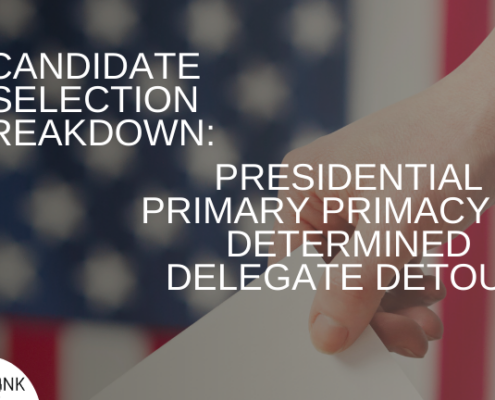
Candidate Selection Breakdown: Presidential Primary Primacy or Determined Delegate Detour
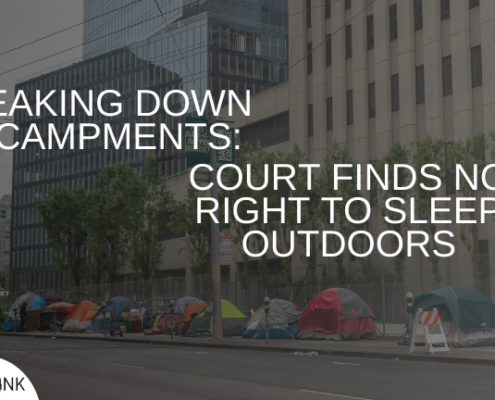
Breaking Down Encampments: Court Finds no Right to Sleep Outdoors

Underfunding Overdose Alternatives: Price Controls Hinder Search for Non-Addictive Opioids

Unlocking Affordable Housing: Sources and Solutions for Cost Crisis
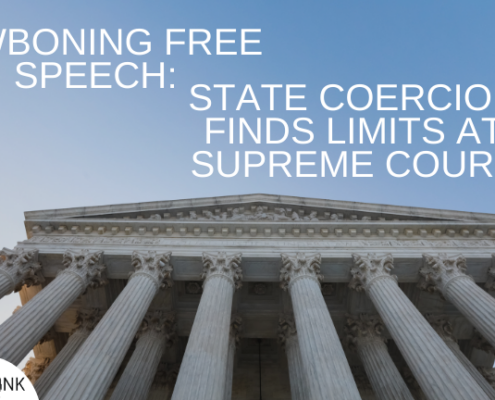
Jawboning Free Speech: State Coercion Finds Limits at Supreme Court
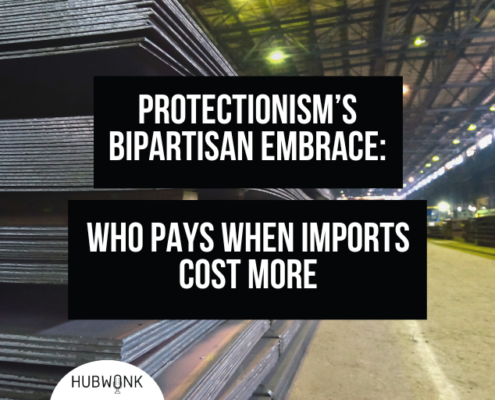
Protectionism’s Bipartisan Embrace: Who Pays When Imports Cost More
